What are the basic functions of excel?
The basic functions of excel are: 1. SUM, used for summing, the syntax "sum(value 1, value 2...)"; 2. AVERAGE, used to calculate the average, the syntax "AVERAGE (value 1, value 2...)"; 3. count, used to calculate the number of cells, the syntax is "COUNT (value 1, value 2...)" and so on.

The operating environment of this tutorial: Windows 7 system, Microsoft Office Excel 2016 version, Dell G3 computer.
excel basic functions
1. SUM function: The function of the SUM function is to sum. Syntax: sum(Number 1,Number 2...)
For example: Count a cell range: =sum(A1:A10) Count multiple cell ranges: =sum( A1:A10,C1:C10)
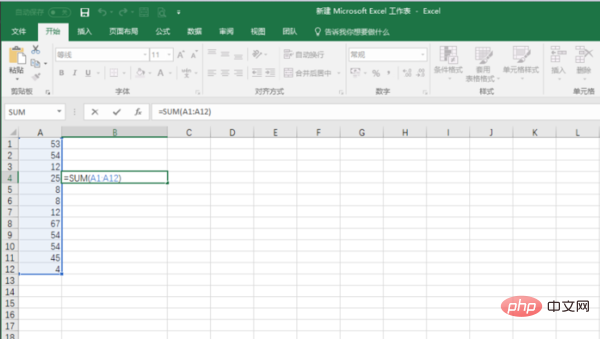
2. AVERAGE function: The function of Average is to calculate the average. Syntax: AVERAGE(Number 1,Number 2...)
For example: Calculate the average of multiple cells =AVERAGE(A1:A12)
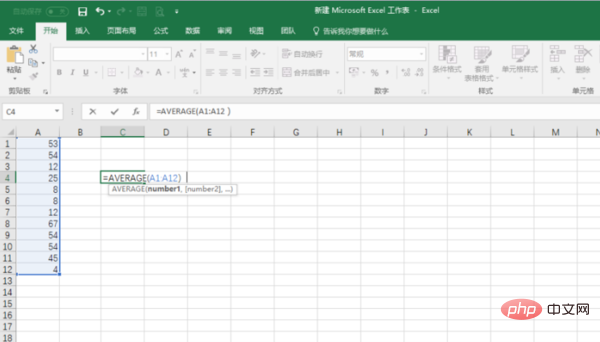
3. Count function: Its function is to count the number of cells. Syntax: COUNT(value 1, value 2...)
For example =COUNT(A1:A12)
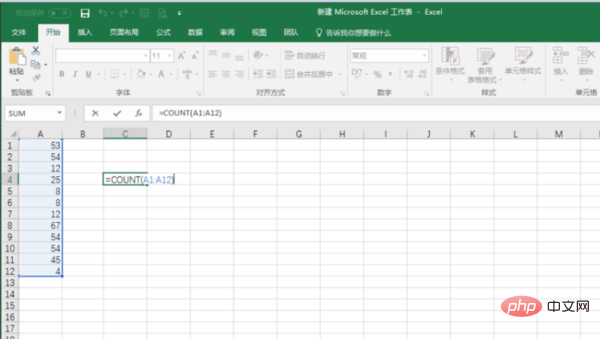
4, IF function: IF function Its function is to judge a condition and then return the specified value based on the result of the judgment.
IF function formula is: =IF (logical judgment, the result when it is TRUE, the result when it is FALSE)
For example: the given condition is A1>A5, if the comparison result is TRUE, then the IF function returns the value of the second parameter; if it is FALSE, it returns the value of the third parameter. =IF(A1>A5,1,2)
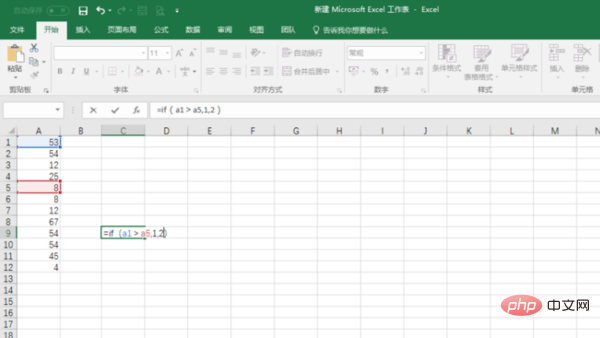
5. NOW function and TODAY function: NOW function returns date and time. The TODAY function only returns the date.
NOW function and TODAY function have no parameters, just use a pair of brackets: =NOW()=TODAY()
Suppose you want to calculate the total number of days a project has been carried out until today. ?=TODAY()-start date, the number obtained is the number of days for the project.
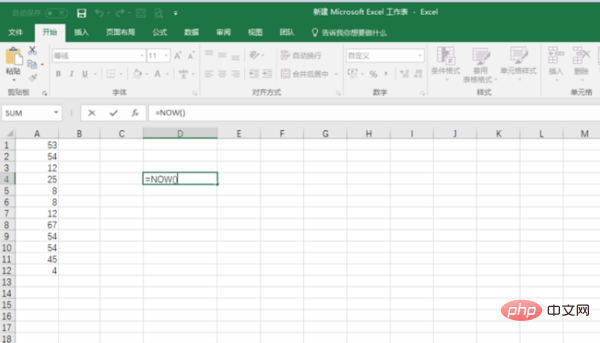
#6. VLOOKUP function: The VLOOKUP function is used to find data in the table.
The syntax formula of the function is: =VLOOKUP(lookup value, area, the content of which column to return, 1 approximate match 0 exact match)
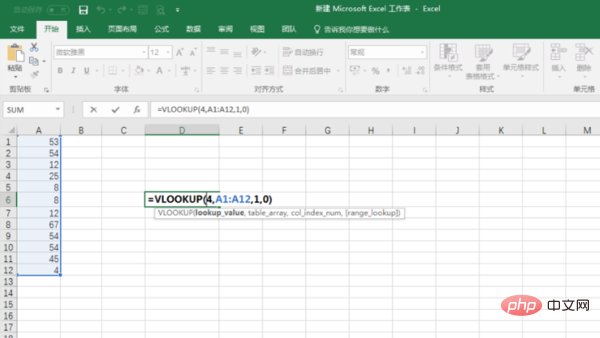
7. Function name: ABS
Main function: Find the absolute value of the corresponding number.
Usage format: ABS(number)
Parameter description: number represents the value or referenced cell whose absolute value needs to be calculated.
Application example: If you enter the formula: =ABS(A2) in cell B2, whether you enter a positive number (such as 100) or a negative number (such as -100) in cell A2, it will be displayed in B2 Output a positive number (such as 100). Use relative references
Special reminder: If the number parameter is not a numerical value, but some characters (such as A, etc.), the error value "#VALUE!" will be returned in B2.
8. Function name: AND
Main function: Return logical value: If all parameter values are logical "TRUE", then return logical "TRUE", otherwise return logical "FALSE".
Usage format: AND(logical1,logical2,...)
Parameter description: Logical1,Logical2,Logical3...: Indicates the condition value or expression to be tested, up to 30 of these .
Application example: Enter the formula in cell C5: =AND(A5>=60,B5>=60) and confirm. If TRUE is returned in C5, it means that the values in A5 and B5 are both greater than or equal to 60. If FALSE is returned, it means that at least one of the values in A5 and B5 is less than 60.
Special reminder: If the specified logical condition parameter contains a non-logical value, the function returns the error value "#VALUE!" or "#NAME".
9. Function name: AVERAGE
Main function: Find the arithmetic average of all parameters.
Using format: AVERAGE(number1,number2,…)
Parameter description: number1,number2,…: The average value or reference cell (area) needs to be calculated, and the parameter does not More than 30.
Application example: Enter the formula in cell B8: =AVERAGE(B7:D7,F7:H7,7,8). After confirmation, you can find the area from B7 to D7 and F7 to H7. value and the average value of 7 and 8.
Special reminder: If the reference range contains "0" value cells, they will be counted; if the reference range contains blank or character cells, they will not be counted.
10. Function name: COLUMN
Main function: Display the column label value of the referenced cell.
Usage format: COLUMN(reference)
Parameter description: reference is the referenced cell.
Application example: Enter the formula in cell C11: =COLUMN(B11). After confirmation, it will be displayed as 2 (i.e. column B).
Special reminder: If you enter the formula: =COLUMN() in cell B11, 2 will also be displayed; correspondingly, there is a function that returns the row label value-ROW(reference).
11. Function name: CONCATENATE
Main function: Connect multiple character texts or data in cells together and display them in one cell.
Usage format: CONCATENATE(Text1, Text...)
Parameter description: Text1, Text2... are the character text or referenced cells that need to be connected.
Application example: Enter the formula in cell C14: =CONCATENATE(A14,"@",B14,".com"). After confirmation, the characters, @, and B14 in cell A14 can be The characters in the cell and .com are connected into a whole and displayed in cell C14.
Special reminder: If the parameter is not a referenced cell and is in text format, please add double quotes in English to the parameter. If you change the above formula to: =A14&"@"&B14&". com" can achieve the same purpose.
12. Function name: COUNTIF
Main function: Count the number of cells in a certain cell range that meet the specified conditions.
Usage format: COUNTIF(Range,Criteria)
Parameter description: Range represents the cell range to be counted; Criteria represents the specified conditional expression.
Application example: Enter the formula in cell C17: =COUNTIF(B1:B13,">=80"). After confirmation, you can count the values in the cell range from B1 to B13 that are greater than or equal to The number of cells is 80.
Special reminder: Blank cells are allowed to appear in the referenced cell range.
Related learning recommendations: excel tutorial
The above is the detailed content of What are the basic functions of excel?. For more information, please follow other related articles on the PHP Chinese website!

Hot AI Tools

Undresser.AI Undress
AI-powered app for creating realistic nude photos

AI Clothes Remover
Online AI tool for removing clothes from photos.

Undress AI Tool
Undress images for free

Clothoff.io
AI clothes remover

Video Face Swap
Swap faces in any video effortlessly with our completely free AI face swap tool!

Hot Article

Hot Tools

Notepad++7.3.1
Easy-to-use and free code editor

SublimeText3 Chinese version
Chinese version, very easy to use

Zend Studio 13.0.1
Powerful PHP integrated development environment

Dreamweaver CS6
Visual web development tools

SublimeText3 Mac version
God-level code editing software (SublimeText3)

Hot Topics
 1664
1664
 14
14
 1423
1423
 52
52
 1319
1319
 25
25
 1269
1269
 29
29
 1249
1249
 24
24
 Tips for dynamically creating new functions in golang functions
Apr 25, 2024 pm 02:39 PM
Tips for dynamically creating new functions in golang functions
Apr 25, 2024 pm 02:39 PM
Go language provides two dynamic function creation technologies: closure and reflection. closures allow access to variables within the closure scope, and reflection can create new functions using the FuncOf function. These technologies are useful in customizing HTTP routers, implementing highly customizable systems, and building pluggable components.
 Considerations for parameter order in C++ function naming
Apr 24, 2024 pm 04:21 PM
Considerations for parameter order in C++ function naming
Apr 24, 2024 pm 04:21 PM
In C++ function naming, it is crucial to consider parameter order to improve readability, reduce errors, and facilitate refactoring. Common parameter order conventions include: action-object, object-action, semantic meaning, and standard library compliance. The optimal order depends on the purpose of the function, parameter types, potential confusion, and language conventions.
 Complete collection of excel function formulas
May 07, 2024 pm 12:04 PM
Complete collection of excel function formulas
May 07, 2024 pm 12:04 PM
1. The SUM function is used to sum the numbers in a column or a group of cells, for example: =SUM(A1:J10). 2. The AVERAGE function is used to calculate the average of the numbers in a column or a group of cells, for example: =AVERAGE(A1:A10). 3. COUNT function, used to count the number of numbers or text in a column or a group of cells, for example: =COUNT(A1:A10) 4. IF function, used to make logical judgments based on specified conditions and return the corresponding result.
 Comparison of the advantages and disadvantages of C++ function default parameters and variable parameters
Apr 21, 2024 am 10:21 AM
Comparison of the advantages and disadvantages of C++ function default parameters and variable parameters
Apr 21, 2024 am 10:21 AM
The advantages of default parameters in C++ functions include simplifying calls, enhancing readability, and avoiding errors. The disadvantages are limited flexibility and naming restrictions. Advantages of variadic parameters include unlimited flexibility and dynamic binding. Disadvantages include greater complexity, implicit type conversions, and difficulty in debugging.
 What are the benefits of C++ functions returning reference types?
Apr 20, 2024 pm 09:12 PM
What are the benefits of C++ functions returning reference types?
Apr 20, 2024 pm 09:12 PM
The benefits of functions returning reference types in C++ include: Performance improvements: Passing by reference avoids object copying, thus saving memory and time. Direct modification: The caller can directly modify the returned reference object without reassigning it. Code simplicity: Passing by reference simplifies the code and requires no additional assignment operations.
 How to write efficient and maintainable functions in Java?
Apr 24, 2024 am 11:33 AM
How to write efficient and maintainable functions in Java?
Apr 24, 2024 am 11:33 AM
The key to writing efficient and maintainable Java functions is: keep it simple. Use meaningful naming. Handle special situations. Use appropriate visibility.
 What is the difference between custom PHP functions and predefined functions?
Apr 22, 2024 pm 02:21 PM
What is the difference between custom PHP functions and predefined functions?
Apr 22, 2024 pm 02:21 PM
The difference between custom PHP functions and predefined functions is: Scope: Custom functions are limited to the scope of their definition, while predefined functions are accessible throughout the script. How to define: Custom functions are defined using the function keyword, while predefined functions are defined by the PHP kernel. Parameter passing: Custom functions receive parameters, while predefined functions may not require parameters. Extensibility: Custom functions can be created as needed, while predefined functions are built-in and cannot be modified.
 C++ Function Exception Advanced: Customized Error Handling
May 01, 2024 pm 06:39 PM
C++ Function Exception Advanced: Customized Error Handling
May 01, 2024 pm 06:39 PM
Exception handling in C++ can be enhanced through custom exception classes that provide specific error messages, contextual information, and perform custom actions based on the error type. Define an exception class inherited from std::exception to provide specific error information. Use the throw keyword to throw a custom exception. Use dynamic_cast in a try-catch block to convert the caught exception to a custom exception type. In the actual case, the open_file function throws a FileNotFoundException exception. Catching and handling the exception can provide a more specific error message.




